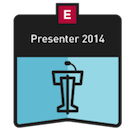Sunday, February 23, 2014
Wednesday, February 19, 2014
Educause Connect: Portland
Portland, Oregon was the first of three test cities for a new model of Educause conference event known as Educause Connect. Tag line: Solve, Network, and Grow - Less "Conference." More Professional Development. Below are my thoughts as a participant and presenter (now known as "content leader").
Online pre-conference meetings were scheduled for content leaders and included our designated learning track facilitators. The meetings were designed to help us learn about the new learning format and how it was different from past conference events. We learned that changing to the Connect learning format meant our sessions were to be less about presentations and more about facilitated dialog, conversations. Like we often hear in higher ed, it's time to end the sage on the stage. And they really meant it. Before our second pre-conference online meeting we were notified to be ready to tell the group what specific interactive strategies we would use during our session. Preparing for that meeting helped my colleague and I to nail down a couple of tools to use during our session.
The first tool we chose was TodaysMeet along with the #EConnect14 conference hashtag for those on twitter as a back channel. (A benefit of TodaysMeet is that it works on most devices and no login or account is required to start using.) Participants were asked to introduce themselves in TodaysMeet at the start of our session to familiarize them with the tool. I asked a couple of questions during the second slide; after that the session participants led the way with questions and comments throughout (some raised hands to speak, some spoke out, and others posted on TodaysMeet). My co-presenter (or co-content leader?) was able to address questions being posted on TodaysMeet and those raising their hands, while I shared and forwarded slides, and conversation ended up flowing nicely.
The other activity for engaging the group was to participate in a rubric activity created by my colleague and co-presenter, Professor Anna Berardi. The rubric activity was well received. Unfortunately, due to the level of participation in discussion, we ran short of time and the activity had to be rushed. We would rethink that strategy for next time, perhaps mentioning a discussion cut off time at the start and beginning the rubric activity sooner.
In the end, I thought our session went well (evaluations coming soon, and we'll see :) ). It helped that the keynote speaker, Kevin D. Jones, talked about the value of failing, that it was okay to fail and if we weren't failing we weren't taking risks, weren't learning to trust, weren't really learning at all, and that was a negative fail. At least that's how I heard it. Bottom line, the keynote was encouraging and helped me relax as did the new format. I found it easier to share and have a conversation rather than the more traditional presentation format. Overall, I liked the new Educause Connect learning format and I'm looking forward to sharing takeaways with librarians and others at my university.
Regarding sessions: A session by ASU librarians has piqued my interest in digital badges and I plan to further investigate. I ended up jumping over to the Mobile/BYOE track the second day and was fascinated by CSUN's tablet initiative. And I thoroughly enjoyed the future trends in mobile session.
I attended the Educause Regional Conference in Portland in 2012 and have attended the larger Educause ELI conference in the past. The new Connect format helps in making connections and allows for deeper learning in a particular track. The last day of the conference, with the exception of the closing keynote, was mostly conversational led by our track facilitators. In our case, the facilitators for the online learning track, John Farquhar and Crista Copp, did an excellent job throughout. Their role in the event was helpful and important, they kept us on track. Good facilitators seem key to the success of the new format.
The PDF of our presentation is on the Educause Connect page in the box below with the exception of the rubric created by Professor Berardi. We're working on writing up our experience for publication and will include the rubric at that time. Our slides have been uploaded to Slideshare.
Subscribe to:
Posts (Atom)


